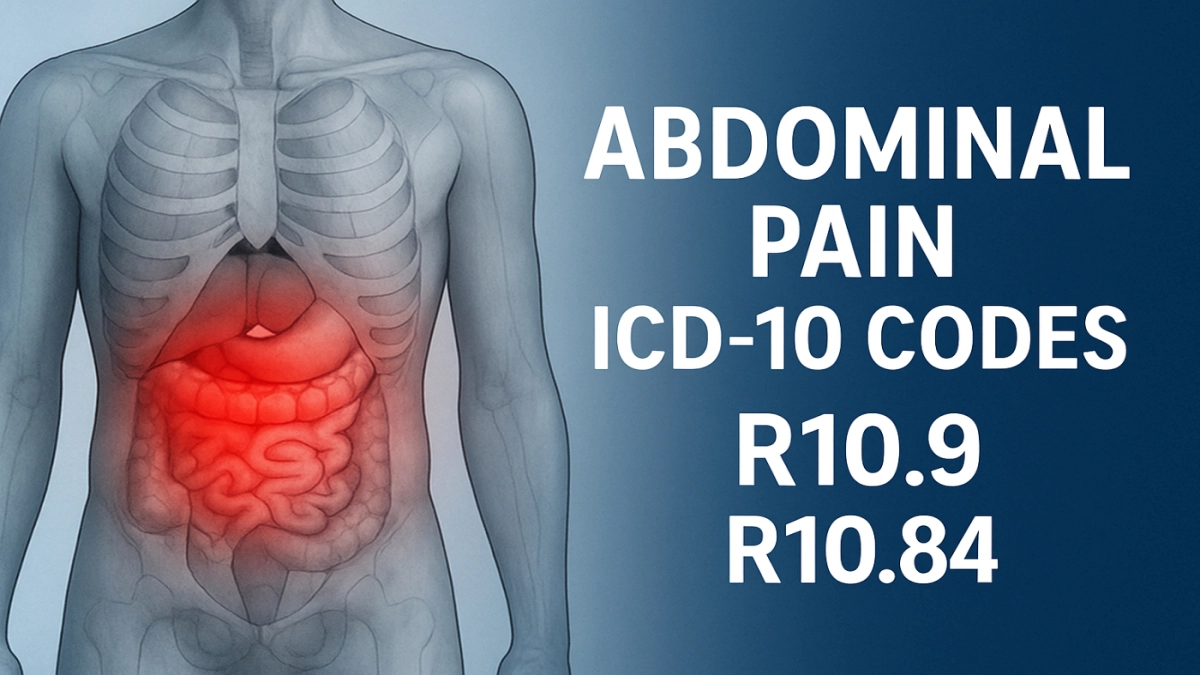Abdominal pain is one of the most common reasons patients show up at clinics, urgent care centers, and ERs. From minor digestive issues to red-flag emergencies, it covers a wide spectrum. For billers and providers, that means precision in ICD-10 coding isn’t optional—it’s essential.
Here’s the thing: icd 10 code for abdominal pain that doesn’t offer a one-size-fits-all code for abdominal pain. There’s nuance. If you choose a vague or incorrect code, it can lead to claim denials, underpayment, or audits. So, let’s break this down into what actually matters when coding abdominal pain—and how to do it right.
What Is Abdominal Pain ICD-10?
The ICD-10 code for unspecified abdominal pain is R10.9 — but relying on that as your default can cause problems. Think of R10.9 as a placeholder, not a go-to. It’s there when all else fails, but payers prefer—and sometimes require—more specificity.
ICD-10 separates abdominal pain based on location, duration, and clinical findings. Here’s a snapshot of how it breaks down:
| ICD-10 Code | Description |
|---|---|
| R10.0 | Acute abdomen |
| R10.1 | Pain localized to upper abdomen |
| R10.2 | Pain localized to lower abdomen |
| R10.3 | Pain localized to other parts of abdomen |
| R10.4 | Other and unspecified abdominal pain |
| R10.9 | Unspecified abdominal pain |
Understanding the ICD-10 Structure for Abdominal Pain
Each of the codes above expands further. For instance:
- R10.10 – Upper abdominal pain, unspecified
- R10.11 – Right upper quadrant pain
- R10.12 – Left upper quadrant pain
The same logic applies for lower abdominal pain and other subcategories. So, don’t just stop at “R10.2”—go one layer deeper whenever possible.
Top Reasons for icd 10 Code for Abdominal Pain
Let’s look at common clinical causes that often correspond with abdominal pain ICD-10 codes:
- Appendicitis – K35 series
- Cholecystitis/Gallstones – K81, K80
- Diverticulitis – K57
- Pancreatitis – K85
- Kidney Stones – N20
- Gastroenteritis – A09
- Irritable Bowel Syndrome – K58
- Constipation – K59.0
Point being: if the abdominal pain is due to a specific diagnosis, you should code that primary condition—not just R10.x.
Coding Guidelines: When and How to Use R10.x
Here’s where many coders slip up. According to ICD-10-CM coding guidelines:
- Symptom codes (like R10.x) should only be used when a definitive diagnosis is not yet established.
- If the pain is documented as the main reason for the visit and no underlying cause is confirmed, then yes—use the appropriate R10 code.
- If the provider suspects a condition but hasn’t confirmed it, consider pairing the symptom code with a “suspected” diagnosis (if payer allows).
How to Choose the Right ICD-10 Code for Abdominal Pain
Step-by-Step Process:
- Check documentation – Is the location mentioned? Right lower quadrant vs. diffuse?
- Look for cause – Is the pain tied to a confirmed diagnosis like appendicitis or pancreatitis?
- Timeframe – Is the pain acute, chronic, intermittent?
- Avoid R10.9 unless necessary – Always favor specificity.
- Review payer guidelines – Some insurers reject unspecified codes outright.
Real-World Coding Examples
Here’s how this looks in action:
- Example 1: A 45-year-old presents with right lower quadrant pain, no known diagnosis.
→ Code: R10.31 (Right lower quadrant pain) - Example 2: A 32-year-old with epigastric pain, diagnosed with gastritis.
→ Code: K29.70 (Gastritis, unspecified, without bleeding) - Example 3: A 58-year-old with diffuse abdominal pain and no diagnosis yet.
→ Code: R10.84 (Generalized abdominal pain)
These examples show how to move from symptom-based to diagnosis-based coding when appropriate.
Common Pitfalls and Coding Challenges
Some common issues that trip people up:
- Using R10.9 too often — It’s tempting, but lazy coding.
- Ignoring documentation details — Left vs. right, upper vs. lower, matters.
- Coding symptom + diagnosis together — If a definitive diagnosis is made, don’t also code the symptom unless it’s clinically distinct.
Best Practices for icd 10 code for abdominal pain
- Always read the full note, not just the chief complaint.
- Push for specificity in documentation — You can’t code what’s not written.
- Stay current on payer edits — Some plans routinely deny unspecified codes.
- Audit frequently denied claims — Look for patterns with R10.9 and revise documentation strategy if needed.
ICD-10 vs. ICD-9: Why It Matters
In ICD-9, abdominal pain was typically coded as 789.x, which was far more limited. ICD-10’s R10.x codes offer granularity and localization, which allows for better analytics, reimbursement justification, and clinical research.
If you’re comparing abdominal pain ICD-10 vs ICD-9, the takeaway is clear: ICD-10 forces coders and providers to document better and code with more precision.
Benefits of Using the Right ICD-10 Code
- Faster reimbursements
- Lower denial rates
- Better documentation trail
- More useful data for population health and quality metrics
It’s not just about insurance. Good coding reflects good clinical care.

